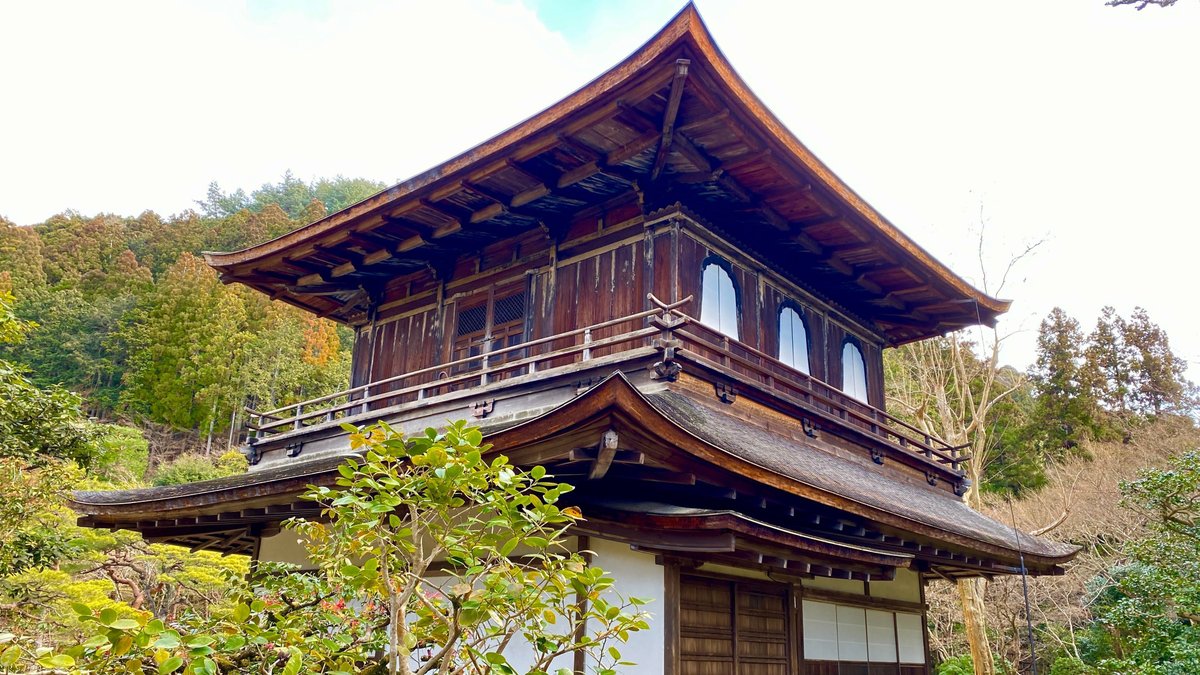
【京都時間.jp】第19回 足利義政の夢:銀閣寺と東山文化の再発見
足利義政の夢:銀閣寺と東山文化の再発見
銀閣寺、正式名称を東山慈照寺というこの歴史的建造物は、京都の東山に位置し、相国寺の塔頭寺院の一つです。この寺院は室町時代の文化の精髄を表すものであり、特に足利義政の美意識と精神的遺産を現代に伝えています。義政は9歳で家督を継ぎ、15歳で将軍職を引き継ぎました。彼は生涯を通じて美意識を追求し、それは東山文化として知られる簡素枯淡の美を体現する一大山荘、東山殿の創建に結実しました。

銀閣寺は京都の東山地区に位置しており、この地域は歴史的に重要で、多くの寺院や遺跡が存在します。特に大文字山はその一つで、毎年行われる送り火で知られています。銀閣寺はこの山の麓に位置しており、周辺は歴史と自然の美しさに満ちています。

義政の政治生活は困難に満ちていましたが、彼は東山文化を育て、芸術や文学への関心を深めました。特に禅宗と芸術の融合は、この時代の特徴であり、多くの文化的成果を生み出しました。義政は政務を息子に譲った後、東山山荘に移り住み、出家しました。この山荘は、義政が好んだ西芳寺(苔寺)を模範にして造られ、また祖父義満の舎利殿(金閣)に倣って観音殿が建てられました。

義政の死後、遺命により東山山荘は禅寺に改められ、慈照寺と命名されました。以降、寺院は何度も修復され、今日まで存続しています。銀閣寺は臨済宗相国寺派に属し、その精神的価値は日本の歴史や文化に深く根ざしています。相国寺自体も、足利歴代将軍によって建てられた禅宗の寺院であり、金閣寺と共に重要な地位を占めています。

銀閣寺を訪れることは、日本の歴史、文化、そして美の追求における深い理解を得る経験です。義政の生涯と彼が追求した美の形式を通じて、この地は時代を超えてその価値を保ち続けています。銀閣寺は、美しさと歴史的重要性が融合した、日本の文化遺産の素晴らしい例です。

銀閣寺を拝観することは単なる観光体験を超えたものです。この場所は、日本文化の深淵に触れることを可能にします。義政の生涯と東山文化への情熱は、銀閣寺の建築と庭園の美しさに色濃く反映されており、日本の過去への敬意と、時間を超えた美の価値を感じさせます。寺院の静けさと落ち着いた雰囲気は、訪れる人々に平和と静寂をもたらし、現代の忙しい生活から一時的に解放される感覚を提供してくれます。

日本の伝統と文化は、銀閣寺の静寂の中で活き活きとしています。この場所は、過去と現在が融合し、訪れる者に日本文化の真髄を教えてくれます。この地を訪れたことで、私の心は日本文化の豊かさと深さに満たされ、その敬意と理解がより一層深まりました。銀閣寺は、その美しさ、歴史、そして文化的意義において、誰もが訪れるべき日本の宝です。

Ashikaga Yoshimasa's Dream: Rediscovering Ginkaku-ji and the Higashiyama Culture
Ginkaku-ji, officially named Higashiyama Jisho-ji, is a historical edifice located in the Higashiyama district of Kyoto, serving as one of the sub-temples of Shokoku-ji Temple. This temple is a representation of the essence of the Muromachi period's culture, especially conveying the aesthetic sensibilities and spiritual legacy of Ashikaga Yoshimasa to the modern era. Yoshimasa inherited the family headship at the age of 9 and took over as shogun at 15. Throughout his life, he pursued aesthetic refinement, culminating in the creation of Higashiyama Dono, a grand villa embodying the beauty of simplicity and austerity, known as Higashiyama culture.
Ginkaku-ji is situated in Kyoto's Higashiyama area, a region historically significant with numerous temples and historic sites. Notably, Mount Daimonji, known for its annual Gozan no Okuribi bonfire, is one of them. Ginkaku-ji is located at the base of this mountain, surrounded by the beauty of history and nature.
Yoshimasa's political life was fraught with difficulties, but he nurtured Higashiyama culture, deepening his interest in arts and literature. The fusion of Zen Buddhism and art was a hallmark of this era, producing many cultural achievements. After handing over his political duties to his son, Yoshimasa moved to the Higashiyama villa, took monastic vows, and lived there. This villa was modeled after his favorite Saiho-ji (Koke-dera or Moss Temple) and also included a Kannon hall, following his grandfather Yoshimitsu's reliquary hall (Kinkaku or Golden Pavilion).
After Yoshimasa's death, as per his last wishes, the Higashiyama villa was converted into a Zen temple and named Jisho-ji. Since then, the temple has been restored many times and continues to exist to this day. Ginkaku-ji belongs to the Rinzai school's Shokoku-ji sect, and its spiritual value is deeply rooted in Japan's history and culture. Shokoku-ji itself, a Zen temple built by successive Ashikaga shoguns, holds an important place alongside Kinkaku-ji.
Visiting Ginkaku-ji is an experience that provides a deep understanding of Japanese history, culture, and the pursuit of beauty. Through Yoshimasa's life and the forms of beauty he pursued, this place continues to retain its value across generations. Ginkaku-ji is a splendid example of Japan's cultural heritage, where beauty and historical significance merge.
Visiting Ginkaku-ji transcends a mere tourist experience. It offers an opportunity to touch the depths of Japanese culture. Yoshimasa's life and passion for Higashiyama culture are vividly reflected in the architecture and beauty of the gardens of Ginkaku-ji, evoking respect for Japan's past and the timeless value of beauty. The temple's tranquility and serene atmosphere bring peace and stillness to its visitors, offering a respite from the hustle of modern life.
In the silence of Ginkaku-ji, Japan's traditions and culture come alive. This place, where the past and present merge, teaches the essence of Japanese culture to its visitors. My visit filled my heart with the richness and depth of Japanese culture, deepening my respect and understanding. Ginkaku-ji, in its beauty, history, and cultural significance, is a treasure of Japan that everyone should visit.
